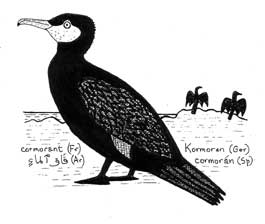|
|
|
| Colney Nature Watch |
| A series of articles on the wild life in London Colney |
| Cormorant |

You're at the seaside. You see a large black bird, with a
slight mauvish tinge to its feathers. It is almost certainly a cormorant,
Cormorants have white patches on their faces, and when they've caught more
fish than they can eat - they carry them in a yellow pouch beneath their
throat Summertime, there are around ten thousand pairs breeding in the UK:
in the winter - rather more. Moroccan readers will know the Moroccan sub
species has a white breast, and Chinese readers have probably noticed the
Chinese sub-species has a greenish tinge to its feathers.
The only Biritsh bird you are likely to confuse with a cormorant is the
shag - which is darker, smaller and has a steeper fore-head.
You will always
see cormorants if you go to the RSPB reserve at Rye House - in the Lee Valley.
They are common in the Thames, particularly between Tower Bridge and Westminster
Bridge. I've only once seen a cormorant in our village - at Long Lake one
wet Saturday in August. Whenever you see lots of cormorants - you know there
is a healthy, breeding population of fish. Cormorants eat mainly fish -
and many anglers would like to see them all exterminated. However, others
have a healthy respect of cormorants. The City of Liverpool's coat of arms
carries a shield, and on it there's a cormorant with a piece of seaweed
in its beak. People who would like to see the end of cormorants should ponder
the example of Chinese fishermen - who use them to help catch fish |
|
|




